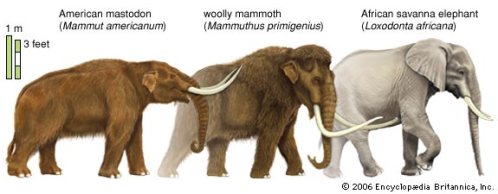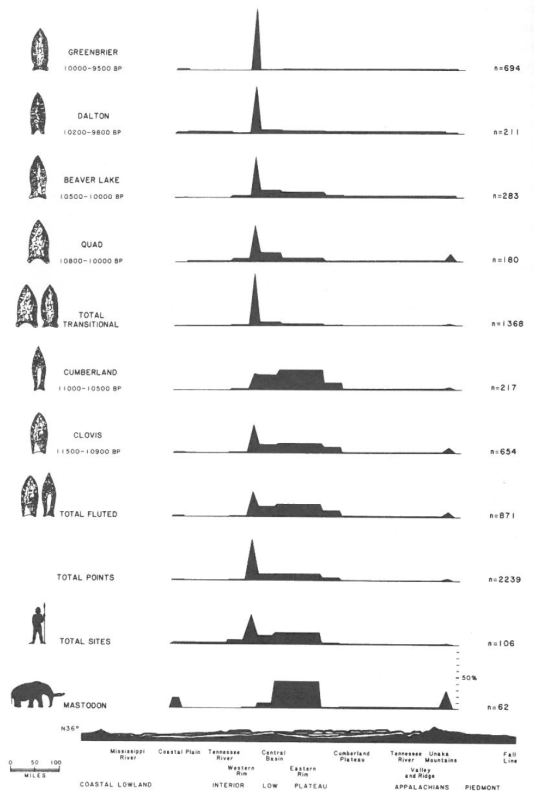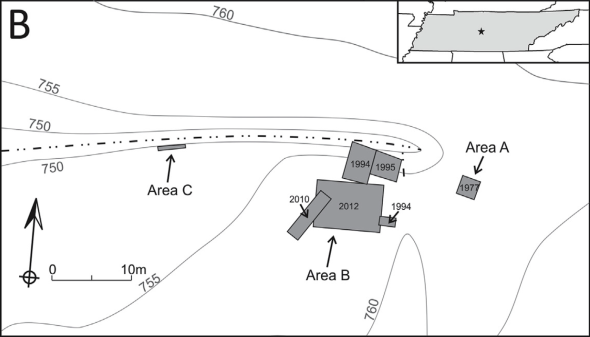30 Days of Tennessee Archaeology, Day 11
Jesse W. Tune
Department of Anthropology, Fort Lewis College
How, when, from where, and by who were the Americas originally occupied is a burning question in archaeology that has persisted for over a century. Currently, the most compelling evidence that most archaeologists can agree with indicates that the first people in the Americas migrated across Beringia and into North America sometime around 16,000 years ago. While there are some alternative ideas, much more evidence is needed before most archaeologists will considered them to be realistic.
As it turns out, Tennessee is an exceptionally place to study early Paleoindian archaeology and the antiquity of human occupation of the Americas. Some of the densest concentrations of Paleoindian artifacts in North America occur in Tennessee. This has led to speculation about Tennessee’s role in the initial occupation of the North American continent.
Interestingly, Tennessee also has a particularly dense concentration of mastodons. While mammoths are typically the first thing people think of when pondering Pleistocene animals, mastodons were much more common in some areas like the midcontinent United States. We know from sites mainly in the western United States that Clovis people co-existed with mammoths and mastodons. There are even some mammoth and mastodon sites that have been dated to earlier than Clovis (that is, they are older than 13,200 calendar years ago). So that being said, if we’re interested in searching for archaeological sites associated with the first people in the Americas, sites with Pleistocene megafauna are a good place to start. Take for example Jessi Halligan’s research at the Page-Ladson site in Florida.

Figure 1. Size comparison of mammoths, mastodons, and humans. From back to front, a Columbian mammoth, an African elephant and an American mastodon next to a 6-foot-tall human. Image from the The Anza-Borrego Desert Paleontology Society, https://www.anzaborregopaleo.org/about-mammoths.html.
In 1994 Emanuel Brietburg and John Broster, with the Tennessee Division of Archaeology (TDOA), conducted a study comparing the distributions of mastodon remains and Paleoindian artifacts throughout the state. They found that people and mastodons were most common in the Central Basin and Highland Rim in the central part of the state. So at face value, it seems like there is a good chance people and mastodons were coexisting and potentially interacting with each other in Tennessee at the end of the Pleistocene.

Figure 2. Distributions of Paleoindian points and mastodon remains in Tennessee. Image from Breitburg and Broster 1994.
However, when we dig into things a little further, the situation becomes more complicated. Archaeologists have a pretty good understanding of how old Clovis points are thanks to a rigorous dating study of sites all across North America. The Southeast, and Tennessee in particular, however, suffer from a relative lack of radiocarbon dates from early Paleoindian sites. There are numerous reasons for this, and for the sake of brevity, I will not go into the details here. I encourage anyone who wants to know more about this to check out Shane Miller and Joseph Gingerich’s study of this. To further complicate the matter, archaeological sites with unequivocal evidence of humans and mastodons (or really any type of Pleistocene megafauna) interacting is actually quite rare.
This brings us back to the question of what’s the earliest evidence for people living in Tennessee and naturally to a discussion about the Coats-Hines-Litchy site, which is something I’ve written about here before. To briefly review for those who may be unfamiliar… this site was originally identified during the construction of a subdivision and golf course in Brentwood, Tennessee. Archaeologists from the TDOA conducted salvage excavations in the mid-1990s to recover as much archaeological evidence as possible before construction damaged the site. Those excavations led to the identification of possible artifacts and mastodon bones found mixed together. A suite of radiocarbon dates was also obtained from those excavations, and range from about 7,400 to 32,000 calendar years ago. A very similar suite of dates were obtained in 2010 during a small test excavation. However, questions remained as to exactly what the association was between the artifacts and mastodon remains.
In 2012 a large-scale excavation of the Coats-Hines-Litchy site was directed by myself and Michael Waters at the Center of the Study of the First Americans, Texas A&M University. The objectives of that project were to analyze the artifacts previously excavated in the 1990s, investigate the association of artifacts and mastodon bones at the site, re-date the sediments, and document the geologic processes that led to the creation of the site.

Figure 3. Coats-Hines-Litchy site exaction map. Image adapted from Tune et al. 2018.
To summarize the results of that research… our results show that the site is a location where several mastodons died naturally and their bones accumulated in the bottom of a drainage or gully sometime before 30,000 years ago. A few artifacts from nearby sites located upslope of the drainage washed down near the mastodon bones that were eroding into the drainage. The combination of high-energy pulses of water occasionally moving through the drainage and the gravelly sediments produced scratches on some mastodon bones as they tumbled down the drainage. Some of the naturally occurring chert in the drainage also broke apart producing small pieces of debris that look generally similar to human-made artifacts. Anyone interested in reading more of the nitty-gritty details about this project should check out the recent publication on the Coats-Hines-Litchy site.
As scientists, we (archaeologists) must follow the data rather than our feelings. That being said, at this time there is no compelling evidence for a pre-Clovis archaeological site in Tennessee. There is, however, abundant data to support early and very extensive Paleoindian occupations in the state, beginning with Clovis sometime around 13,200 years ago. So while there are currently no pre-Clovis sites known in state, Tennessee remains an important place to research Paleoindian archaeology.
